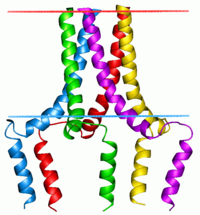
Photo from wikipedia
We have used site-directed spin labeling and electron paramagnetic resonance (EPR) to map interactions between the transmembrane (TM) domains of the sarcoplasmic reticulum Ca2+-ATPase (SERCA) and phospholamban (PLB) as affected… Click to show full abstract
We have used site-directed spin labeling and electron paramagnetic resonance (EPR) to map interactions between the transmembrane (TM) domains of the sarcoplasmic reticulum Ca2+-ATPase (SERCA) and phospholamban (PLB) as affected by PLB phosphorylation. In the cardiac sarcoplasmic reticulum, PLB binding to SERCA results in Ca-dependent enzyme inhibition, which is reversed by PLB phosphorylation at Ser16. Previous spectroscopic studies on SERCA-PLB have largely focused on the cytoplasmic domain of PLB, showing that phosphorylation induces a structural shift in this domain relative to SERCA. However, SERCA inhibition is due entirely to TM domain interactions. Therefore, we focus here on PLB's TM domain, attaching Cys-reactive spin labels at five different positions. In each case, continuous-wave EPR indicated moderate spin-label mobility, with the addition of SERCA revealing two populations, one indistinguishable from PLB alone and another with more restricted rotational mobility, presumably due to SERCA-binding. Phosphorylation had no effect on the rotational mobility of either component but significantly decreased the mole fraction of the restricted component. Solvent-accessibility experiments using power-saturation EPR and saturation-recovery EPR confirmed that these two spectral components were SERCA-bound and unbound PLB and showed that phosphorylation increased the overall lipid accessibility of the TM domain by increasing the fraction of unbound PLB. However-based on these results-at physiological levels of SERCA and PLB, most SERCA would have bound PLB even after phosphorylation. Additionally, no structural shift in the TM domain of SERCA-bound PLB was detected, as there were no significant changes in membrane insertion depth or its accessibility. Therefore, we conclude that under physiological conditions, the phosphorylation of PLB induces little or no change in the interaction of the TM domain with SERCA, so relief of inhibition is predominantly due to the previously observed structural shift in the cytoplasmic domain.
Journal Title: Biophysical journal
Year Published: 2018
Link to full text (if available)
Share on Social Media: Sign Up to like & get
recommendations!